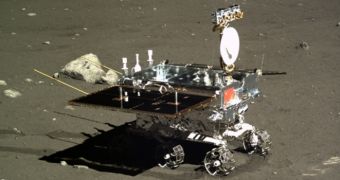Officials with the China National Space Administration (CNSA) announced recently that their Yutu rover, also known as Jade Rabbit, has successfully awakened from its two-week slumber on the surface of the Moon. Due to damage it suffered following a mechanical glitch early on in its mission, the rover is currently immobile, but its antennas are still capable of keeping in touch with Earth.
Both Yutu and the Chang'e-3 lander exited their sleep mode last week, after surviving yet another lunar night. This is the third time this shutdown/wake-up cycle was completed successfully since the two spacecraft landed on the Moon, on December 14, 2013. Chang'e-3 released Yutu from its grasp just a few hours after landing, and the rover has been pushing away from the lander ever since.
Though it managed to survive its third night, Jade Rabbit is currently unable to move at all, CNSA mission controllers told attendants at the Lunar and Planetary Science Conference in The Woodlands, Texas, earlier this week. However, Yutu remains able to communicate with Earth and gather scientific data, Nature News reports.
In late January, a mechanical error occurred in the rover's drive systems, which incapacitated the machine and prevented any additional forward motions. Before the failure occurred, Yutu had already traveled 100 to 110 meters (328-361 feet) on the lunar surface, on the floor of Mare Imbrium. Chinese experts wanted it to reach and explore the rim of a nearby crater, but that goal is no longer achievable.
However, one of the most important scientific goals of the mission – confirming the thickness of basaltic rocks at the landing site – will probably be completed, commented Le Qiao, who holds an appointment as a planetary scientist at the China University of Geosciences in Wuhan. Yutu has already used its ground-penetrating radar to probe rock thickness to a depth of up to 100 meters (328 feet).
The data Jade Rabbit returned to Earth is still being processed, and Le Qiao said that his team was anxious to see whether or not these direct measurements would confirm satellite readings collected from lunar orbit. Currently, the basalt layer is estimated to be 41 to 46 meters (135 to 151 feet) thick.
Attendants at the conference commented that they were expecting to see more data from Yutu, though Chinese researchers are probably just taking their time piecing everything together. What scientists are interested in is comparing rocks in this region of Mare Imbrium to rocks in an area around 500 kilometers (310.6 miles) away, which the Lunokhod-1 rover explored in 1970.
Already, scientific results returned by the alpha-particle X-ray spectrometer aboard Yutu have revealed the presence of chemicals such as magnesium, aluminum, silicon, potassium, and calcium at the landing site, researchers at the Institute of High Energy Physics in Beijing announced in another presentation.

 14 DAY TRIAL //
14 DAY TRIAL //